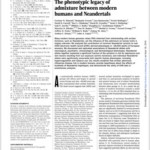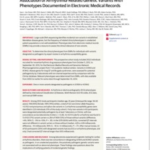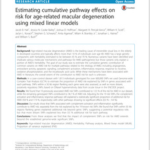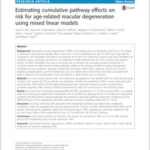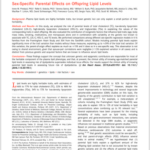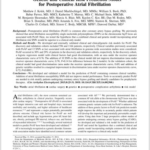Many modern human genomes retain DNA inherited from interbreeding with archaic hominins, such as Neandertals, yet the influence of this admixture on human traits is largely unknown. We analyzed the contribution of common Neandertal variants to over 1000 electronic health record (EHR)-derived phenotypes in 28,000 adults of European ancestry. We discovered and replicated associations of […]
Tag Archives: Phenotype
The phenotypic legacy of admixture between modern humans and Neandertals.
Simonti CN, Vernot B, Bastarache L, Bottinger E, Carrell DS, Chisholm RL, Crosslin DR, Hebbring SJ, Jarvik GP, Kullo IJ, Li R, Pathak J, Ritchie MD, Roden DM, Verma SS, Tromp G, Prato JD, Bush WS, Akey JM, Denny JC, Capra JA,. Many modern human genomes retain DNA inherited from interbreeding with archaic hominins, such […]
Association of Arrhythmia-Related Genetic Variants With Phenotypes Documented in Electronic Medical Records.
Large-scale DNA sequencing identifies incidental rare variants in established Mendelian disease genes, but the frequency of related clinical phenotypes in unselected patient populations is not well established. Phenotype data from electronic medical records (EMRs) may provide a resource to assess the clinical relevance of rare variants.To determine the clinical phenotypes from EMRs for individuals with […]
Association of Arrhythmia-Related Genetic Variants With Phenotypes Documented in Electronic Medical Records.
Van Driest SL, Wells QS, Stallings S, Bush WS, Gordon A, Nickerson DA, Kim JH, Crosslin DR, Jarvik GP, Carrell DS, Ralston JD, Larson EB, Bielinski SJ, Olson JE, Ye Z, Kullo IJ, Abul-Husn NS, Scott SA, Bottinger E, Almoguera B, Connolly J, Chiavacci R, Hakonarson H, Rasmussen-Torvik LJ, Pan V, Persell SD, Smith M, […]
Estimating cumulative pathway effects on risk for age-related macular degeneration using mixed linear models.
Age-related macular degeneration (AMD) is the leading cause of irreversible visual loss in the elderly in developed countries and typically affects more than 10% of individuals over age 80. AMD has a large genetic component, with heritability estimated to be between 45% and 70%. Numerous variants have been identified and implicate various molecular mechanisms and […]
Estimating cumulative pathway effects on risk for age-related macular degeneration using mixed linear models.
Age-related macular degeneration (AMD) is the leading cause of irreversible visual loss in the elderly in developed countries and typically affects more than 10% of individuals over age 80. AMD has a large genetic component, with heritability estimated to be between 45% and 70%. Numerous variants have been identified and implicate various molecular mechanisms and […]
Estimating cumulative pathway effects on risk for age-related macular degeneration using mixed linear models.
Hall JB, Cooke Bailey JN, Hoffman JD, Pericak-Vance MA, Scott WK, Kovach JL, Schwartz SG, Agarwal A, Brantley MA, Haines JL, Bush WS,. Age-related macular degeneration (AMD) is the leading cause of irreversible visual loss in the elderly in developed countries and typically affects more than 10% of individuals over age 80. AMD has a […]
Estimating cumulative pathway effects on risk for age-related macular degeneration using mixed linear models.
Hall JB, Cooke Bailey JN, Hoffman JD, Pericak-Vance MA, Scott WK, Kovach JL, Schwartz SG, Agarwal A, Brantley MA, Haines JL, Bush WS,. Age-related macular degeneration (AMD) is the leading cause of irreversible visual loss in the elderly in developed countries and typically affects more than 10% of individuals over age 80. AMD has a […]
Sex-Specific Parental Effects on Offspring Lipid Levels.
Plasma lipid levels are highly heritable traits, but known genetic loci can only explain a small portion of their heritability.In this study, we analyzed the role of parental levels of total cholesterol (TC), low-density lipoprotein cholesterol (LDL-C), high-density lipoprotein cholesterol (HDL-C), and triglycerides (TGs) in explaining the values of the corresponding traits in adult offspring. […]
Sex-Specific Parental Effects on Offspring Lipid Levels.
Predazzi IM, Sobota RS, Sanna S, Bush WS, Bartlett J, Lilley JS, Linton MF, Schlessinger D, Cucca F, Fazio S, Williams SM,. Plasma lipid levels are highly heritable traits, but known genetic loci can only explain a small portion of their heritability.In this study, we analyzed the role of parental levels of total cholesterol (TC), […]
Genetic and clinical risk prediction model for postoperative atrial fibrillation.
Postoperative atrial fibrillation (PoAF) is common after coronary artery bypass grafting. We previously showed that atrial fibrillation susceptibility single nucleotide polymorphisms (SNPs) at the chromosome 4q25 locus are associated with PoAF. Here, we tested the hypothesis that a combined clinical and genetic model incorporating atrial fibrillation risk SNPs would be superior to a clinical-only model.We […]
Genetic and clinical risk prediction model for postoperative atrial fibrillation.
Kolek MJ, Muehlschlegel JD, Bush WS, Parvez B, Murray KT, Stein CM, Shoemaker MB, Blair MA, Kor KC, Roden DM, Donahue BS, Fox AA, Shernan SK, Collard CD, Body SC, Darbar D,. Postoperative atrial fibrillation (PoAF) is common after coronary artery bypass grafting. We previously showed that atrial fibrillation susceptibility single nucleotide polymorphisms (SNPs) at […]


